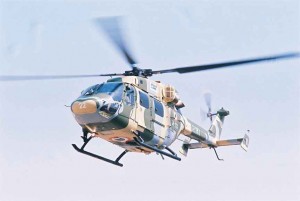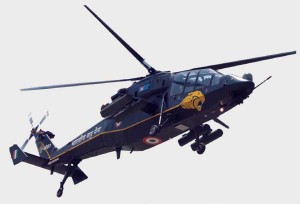Established in 1986, the Army Aviation Corps (AAC) is one of the youngest Corps in the Indian Army. It has operated over all types of terrain from deserts plains, forests and high mountains to perpetually frozen battlefields. Army aviators fly several missions everyday to support forces deployed in high altitude areas. Some of the missions are dedicated to casualty evacuation and routine operations for the AAC. Day in and day out, the AAC also perform a wide range of tasks such as ferrying soldiers to and from the battlefield. Army aviators thus work as a force multiplier by providing rapid movement of men and material at short notice. The AAC has taken part in a number of UN missions and several disaster relief operations in India.
Since its formation, the AAC continues to remain primarily a reconnaissance and observation force…
Established in 1986, the Army Aviation Corps (AAC) is one of the youngest Corps in the Indian Army. It has operated over all types of terrain from deserts plains, forests and high mountains to perpetually frozen battlefields. Army aviators fly several missions everyday to support forces deployed in high altitude areas. Some of the missions are dedicated to casualty evacuation and routine operations for the AAC. Day in and day out, the AAC also perform a wide range of tasks such as ferrying soldiers to and from the battlefield. Army aviators thus work as a force multiplier by providing rapid movement of men and material at short notice. The AAC has taken part in a number of UN missions and several disaster relief operations in India.
Despite the fact that 24 years have gone by since its formation after breaking away from the Indian Air Force (IAF), the AAC continues to remain primarily a reconnaissance and observation force. The induction of the Rudra helicopter appears to be the sole saving grace. To begin with, the AAC needs to replace its 190-odd fleet of ‘Cheetah’ and ‘Chetak’ helicopters that are of 1970s vintage and form the bulk of their rotary wing fleet.
The AAC performs a crucial role both in war and peace time operations. However, with the changing battlefield scenario, more and more air elements are being added to the inventory of land forces all over the world and the Tactical Battle Area will present an entirely different picture in future warfare. The Indian Army requires flexibility and swift action to challenge the enemy forces. With the crucial elements of firepower, reconnaissance, observation and transportation, the Aviation Arm of the Indian Army will be a formidable force with sufficient firepower assets in its inventory. Further, it would be more flexible and effective for Counter Surface Force Operation (CSFO), destruction of enemy air defence assets, tactical transport, Counter-Insurgency Operations (COIN), offensive employment in urban warfare, Search And Rescue (SAR) operations, battlefield support, High Altitude Warfare (HAW), anti-tank role and scout duties.
The Indian Army today needs a sizeable fleet of attack helicopters…
The AAC will have an integral Aviation Brigade, which will have a squadron each of utility, armed and reconnaissance helicopters. Future acquisitions of Light Utility Helicopters (LUH), light attack, Armed Helicopters (AH) and heavy-lift helicopters will greatly enhance the capability of the Indian Army and will be a game changer in any future conflict.
Light Attack and Armed Helicopter Fleet
In keeping with the changing paradigms of modern warfare which has brought out the need for a fleet of attack helicopters as an integral component of assembled firepower, the Indian Army today needs a sizeable fleet of attack helicopters. The Long Term Perspective Plan (LTPP) of the AAC includes the requirement of a combined arm team which would help it to operate across the full spectrum of operations. These assets would be needed for fire support and direct attack roles in support of ground forces. An integrated attack helicopter element will mean better synergy with ground forces in attack.
There is an acute shortage of attack helicopters in the Indian Armed Forces particularly those that have the capability to operate at high altitudes. In this respect, indigenous attack helicopters have enhanced the firepower of the Aviation arm of the Indian armed forces.
The AAC inducted in 2001 the first – Advanced Light Helicopter (ALH) Dhruv manufactured by Hindustan Aeronautics Limited (HAL). Since then, this fleet has grown rapidly and is already on the path to becoming the mainstay of the AAC for day and night operations. The weaponised version of the ALH Weapon Systems Integrated (WSI) also known as the Rudra Mk IV, is the first armed helicopter being produced indigenously and has already been inducted into the AAC in 2013. The Indian Army plans to equip the AAC with 80 Rudra helicopters to form eight squadrons.
HAL is also working on an indigenous attack helicopter called the Light Combat Helicopter (LCH). With the LCH, the ability of the Indian armed forces to take on both the hostile neighbours on the icy Himalayan heights will be considerably enhanced. The Indian Army has ordered 114 LCHs from HAL. Production of these is expected to commence in 2015.
The IAF is set to receive 15 heavy lift Chinook (CH-47F) helicopters…
Both the helicopters are specialised for high altitude warfare and have enormous firepower which makes them effective and efficient. They can be utilised in a wide range of operations such as reconnaissance, troop transport, anti-tank warfare and close air support. They can also take on enemy targets in a battlefield scenario alongside tanks and artillery.
Both the helicopters have all the capabilities which modern day attack helicopters should have. Indigenously producing these state-of-the-art war machines puts India in the select club of countries that can produce sophisticated attack helicopters on their own. The capabilities of these helicopters are on a par with helicopters produced as per world class standards. This gives India a commercial as well as strategic opportunity to export these machines.
Recently, after a long tussle between the Indian Army and the IAF, the Ministry of Defence (MoD) decided that future acquisitions of attack helicopters would be for the Indian Army. The MoD was of the view that attack helicopter would be more meaningful for ground forces and rightfully, the Indian Army must have control over the attack helicopter fleet. The Indian Army can now have its own unit of the Apache attack helicopters. Recent reports indicate that the government has approved four squadrons of the iconic Apache attack helicopters for the Indian Army and the first batch of these machines is expected to be inducted in 2018. The initial batch, which is meant to replace the IAF’s ageing fleet of Soviet-era helicopters, will be armed with Hellfire and Stinger missiles. 39 more are on order for the Indian Army and will be deployed as part of a new Mountain Division which is being raised for operations along the disputed borders with China.
Light Utility/Observation Helicopter Fleet
The Indian Armed Forces have a requirement for 384 helicopters for Reconnaissance and Surveillance role to replace the ageing fleet of Cheetah and Chetak helicopters. India plans to buy 187 single engine indigenously-designed Light Utility Helicopter (LUH) and would import 197 LUH helicopters from a foreign vendor. However, as per media reports, plans to procure 197 choppers from abroad has been cancelled. HAL has now been tasked to produce around 400 LUH for the three services.
The AAC today has a requirement of about 200 LUHs. The first flight of the indigenous LUH is expected in 2015. Production is planned to begin thereafter in 2015 with ten helicopters being produced per year. The rate of production would be scaled up to 36 helicopters per year. Delivery of 187 LUHs by HAL is to be completed by 2022. LUHs are supposed to undertake patrol, casualty evacuation and reconnaissance roles mainly in high altitude areas of 20,000 to 23,000 feet and would be effectively used as Tactical Battle Support Helicopters.








awsome research done by Shantanu k bansal i am proud shantanu k bansal
Amazing research done by Shantanu K Bansal
Amazing , gud research work. !
Great research done by the editor, really liked reading this article.!!.